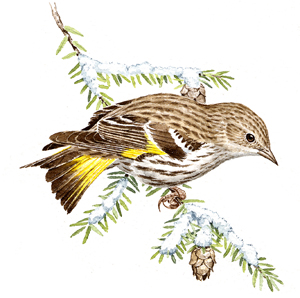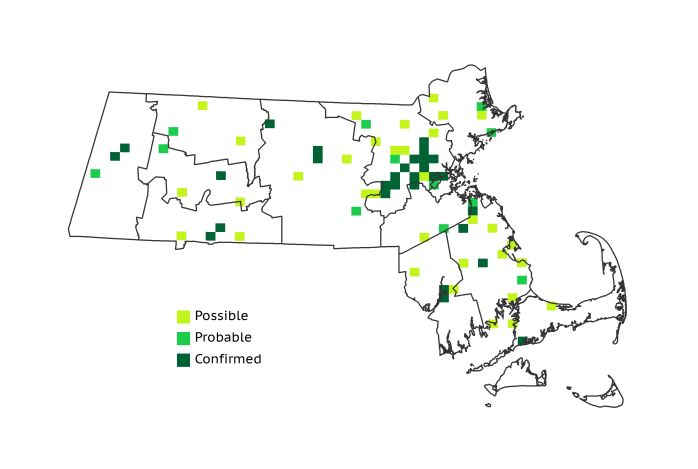Find a Bird
Pine Siskin
Spinus pinus

Local and strongly increasing
“…but I do not know of any locality in our northeastern and northern forests where one can say, ‘We will find the Pine Siskin here this year.’” – Richard C. Harlow, “Tribal Nesting of the Pine Siskin in Pennsylvania”
The Pine Siskin fluctuates in Massachusetts between years of scarcity and years of remarkable abundance, which makes their appearances difficult to predict. Like crossbills, Pine Siskins are boreal finches that spend most years comfortably sequestered in the coniferous forests of Canada and the northern United States. Periodically, however, a change in the cycle of seed cone production brings large numbers of Pine Siskins to Massachusetts during the lean winter months, and some birds regularly remain to breed the following spring.
Historic Status
If Pine Siskins, or Pine Finches, as they were once known, ever bred in Massachusetts during the first half of the nineteenth century, they went undiscovered. Although early observers were aware of the irregular, irruptive winter visitations of the Pine Siskin, “Where they rear their young has not yet been discovered,” wrote William Peabody (Peabody 1839). In 1859, however, a nest was discovered in Cambridge, and in 1883 a second nest was located in Newton (Brewster 1906). Joel Asaph Allen later reported them lingering in Cambridge in June of 1869, and more reports eventually came from Mount Greylock, but, as Edward Howe Forbush noted in Birds of Massachusetts and Other New England States, “…as most of the spruce woods in Massachusetts have been destroyed, the breeding of the Pine Siskin here now would be fortuitous” (Forbush 1929). For the next few decades, reports of breeding Pine Siskins remained scattered.
Atlas 1 Distribution
A major irruption of Pine Siskins occurred during 1978, the penultimate year of Atlas 1 surveys. As a result, siskins were found breeding all over the state in numbers surpassing any known historic numbers. In the central and western parts of the state, evidence of breeding Pine Siskins was reported in at most 3 or 4 blocks in every region. The Coastal Plains and the Boston Basin were a different story, together accounting for 57% of all occupied blocks in the state. Bird feeders were plentiful in the latter region, which likely attracted wintering siskins and encouraged them to remain in the area when the breeding season came around. A lesser but still notable number of Pine Siskins were found breeding in the Bristol/Narragansett Lowlands and on Upper Cape Cod.
Atlas 2 Distribution and Change
Pine Siskins apparently also enjoyed breeding success during the Atlas interval. During the winter of 2008 to 2009 there was another notable irruption and the results of that event were quickly registered by Breeding Bird Atlas volunteers. Of the 182 records received for Pine Siskin, 160 of them were found during 2009. Siskins began nesting as early as March 8, 2008, and were still recorded with fledglings as late as July 28, 2009. There was some stability maintained in their breeding locations, with 19 blocks occupied in both Atlases; however, they did expand into many new blocks during Atlas 2. Aside from the Marble Valleys, Lower Berkshire Hills, and Bristol Lowlands, all other regions posted modest to notable gains for this species, with new and stable blocks outstripping losses in many parts of the state.
Atlas 1 Map

Atlas 2 Map

Atlas Change Map

Ecoregion Data
Atlas 1 | Atlas 2 | Change | ||||||
Ecoregion | # Blocks | % Blocks | % of Range | # Blocks | % Blocks | % of Range | Change in # Blocks | Change in % Blocks |
Taconic Mountains | 0 | 0.0 | 0.0 | 1 | 4.0 | 0.6 | 1 | 6.7 |
Marble Valleys/Housatonic Valley | 3 | 7.7 | 4.1 | 3 | 7.7 | 1.8 | 0 | 0.0 |
Berkshire Highlands | 2 | 3.6 | 2.7 | 7 | 12.7 | 4.3 | 3 | 5.7 |
Lower Berkshire Hills | 0 | 0.0 | 0.0 | 0 | 0.0 | 0.0 | 0 | 0.0 |
Vermont Piedmont | 1 | 5.9 | 1.4 | 3 | 17.6 | 1.8 | 1 | 8.3 |
Berkshire Transition | 1 | 2.6 | 1.4 | 4 | 10.0 | 2.4 | 1 | 3.2 |
Connecticut River Valley | 4 | 7.1 | 5.4 | 14 | 21.5 | 8.5 | 8 | 16.7 |
Worcester Plateau | 4 | 5.1 | 5.4 | 18 | 20.5 | 11.0 | 3 | 6.3 |
Lower Worcester Plateau | 3 | 4.1 | 4.1 | 9 | 11.3 | 5.5 | 3 | 5.6 |
S. New England Coastal Plains and Hills | 30 | 11.1 | 40.5 | 73 | 25.8 | 44.5 | 32 | 14.2 |
Boston Basin | 12 | 21.4 | 16.2 | 13 | 23.2 | 7.9 | 1 | 1.8 |
Bristol and Narragansett Lowlands | 8 | 7.5 | 10.8 | 7 | 6.1 | 4.3 | -2 | -2.0 |
Cape Cod and Islands | 6 | 4.4 | 8.1 | 12 | 8.3 | 7.3 | 5 | 4.2 |
Statewide Total | 74 | 7.6 | 100.0 | 164 | 15.8 | 100.0 | 56 | 6.8 |
Notes
The Pine Siskin shows a significant decreasing Breeding Bird Survey trend in the Eastern US overall.



